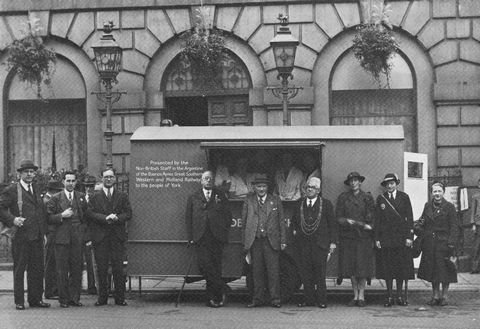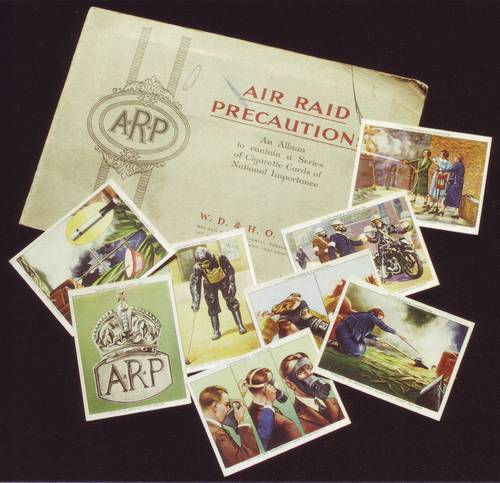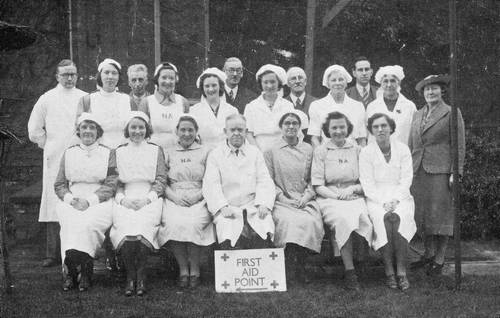York's Civil Defence
In April 1942 York had several searchlights but was not defended by any anti aircraft guns or barrage balloons. However, after the raid, a few guns and balloons were sent to York.
York would need, like many cities, to take care of itself.
Barrage balloons, anti-aircraft guns and searchlights of the type used in WW2
(photo credit: Imperial War Museum)

Those who would coordinate York's response to an attack....the Chief Constable of York (Harry H Herman), the ARP (Air Raid Precaution) Officer (Albert Cook), the Deputy Town Clerk (J Gregg), three members of the ARP Emergency Committee (A G Watson, Alderman Charles T Hutchinson and the Lord Mayor, William Horsman) with representatives of the WVS (Women's Voluntary Service). Others involved in ARP Services would include the National & Auxiliary Fire Services, the Fire Guard and Medical Services providing First Aid Points (photo credit: unknown)
Although the term ARP was still widely used, from 1941, the title Civil Defence had been adopted.
It is estimated that over 1000 people could be called on to assist York in the event of an air-raid.

Established in March 1937, the Air Raid Wardens Service formed the advance guard of Britain’s 1.5 million strong civil defence organisation when war broke out. By the end of the war 6,838 wardens and other Civil Defence workers, including 618 women, were killed as a result of enemy action
York's response to an air raid was coordinated from the Civil Defence Headquarters located behind the historic Guildhall.

The historic 15th Century Guildhall was the HQ of York's Civil Defence Services
(photo credit: unknown)
York was well endowed with public air-raid shelters and a map shows there were 36 public shelters in the centre of the city. The largest in Lower Priory Street could shelter 477 people and the smallest, the Public Lavatory in Parliament Street could hold 50. However, this location was designated "men only" and ladies had to use the shelter in St Sampson's Square!
Official records show that the thirteen wards of York had between them a further 89 shelters.....brick & concrete boxes, concrete lined trenches, archways, converted passages and basements. However, anecdotal evidence strongly suggests that there were many more.
It was felt that the city was immune from the war, so much so that near the centre of the city stood a large shelter where the key was in a small glass case at the end of the shelter with a notice asking people to "break the glass" to obtain the key. It is remarkable that several days after the raid the glass was still unbroken.

The key story, although improbable, appears to have some truth to it.......

A shelter (of the 'brick box' type) in the Clifton area of York (photo credit: still from the 'Longest Night' video)
Residents were encouraged to bury "Anderson shelters" where they could in their back gardens and share them with neighbouring properties. A shelter capable of protecting four people was costed at £3 3s 0d whilst a ten person shelter would cost £5 8s 0d.

An Anderson shelter under construction (photo credit: still from the 'Longest Night' video)
Further protection, inside the home, was offered by creating a "Morrison shelter".
A complete table, priced to the last nut, bolt and washer, cost £2 11s 6d.
In today's money (2015) this is approximately £80.

This type of shelter was surprisingly effective and a number of York residents owe their lives to this design (photo credit: Imperial War Museum)
Air raid sirens were positioned on both the Rowntree's and Terry's factories, the waterworks, Hull Road Printing Works (near the intersection with Melrosegate), the Power Station (on Foss Island), Acomb Infant School and other (as yet) unknown locations.
Air Raid Wardens were based in Warden's Posts which covered an area of up to a quarter of a mile square, encompassing roughly 500 people. The Wardens were locally known and were responsible for logging all incidents and, if necessary, coordinating other civil defence teams. The Post would keep in contact with the Civil Defence Control Centre in the Guildhall either by telephone or by using messengers carrying the ARP/M3 Form.

In addition to completing the above forms, each Warden's Post entered the details into a ledger.
The ARP/M3 (LHS) would be taken by messenger to the Control Centre.
The National Fire Service was created in August 1941 by combining the wartime national Auxiliary Fire Service (AFS) and the local authority fire brigades (about 1,600 of them). This new service was comprised of full and part time members both male and female.

This particular image is of the NFS at their Jarrow Station.....image courtesy of the Old Hebburn, Jarrow and South Shields website
It was quickly learned that extinguishing an incendiary bomb as quickly as possible was of vital importance. Fire Watchers were recruited to patrol industrial premises, and Street Fire Parties to monitor the streets. In August 1941 these services were renamed as the Fire Guard.

Even cigarette manufacturers were used to pass on this message complete with useful tips and techniques.

These cards were issued by W D and H O Wills, the manufacturers of Woodbine cigarettes.
A 'Redhill Scoop' (shown on the lower right hand card) and a bucket of sand could, if used early enough, defeat an incendiary device. (photo credit: Shire Publications)
There were six First Aid Points around York........in Acomb, the City Infirmary (then located on Haxby Road), Rougier Street, Hungate, Clifton and Dringhouses.

Members of one of York's First Aid Points (photo credit: unknown)
The Women's Voluntary Service was born out of the recognition that women would form an essential part of the Civil Defence services. While they did provide refreshments at major incidents and organise shelter and clothing for those "bombed out", they also served at Incident Enquiry Points assisting the Civil Defence in all aspects of their work.
There were twelve Emergency Rest Centres in York, one being the Salvation Army Citadel in Gillygate.

The range of badges issued for the WVS gives some indication of the multiplicity of their tasks.
All the above services were in addition to the traditional protectors of the public..........the Police.
The Police were still responsible for sounding the sirens (before and after a raid), evacuating areas close to unexploded bombs, controlling traffic away from incident sites as well as "maintaining law & order"......although looting was an issue following bombing raids, there are no specific reports of this in York. However, a Post Raid Welfare Report stated...."There are always cases of looting in any community and the less said about them the better."
The pre-war ranks were added to by a Police Reserve (usually retired officers), the Special Constabulary who were given a period of approved training and a Police War Reserve. There was also a Women's Auxiliary Police Corps and the Police Auxiliary Messenger Service (the latter intended to keep lines of communication open).

The classic pose of a WW2 policeman........responsible for traditional and wartime duties.
(photo credit: Imperial War Museum)
